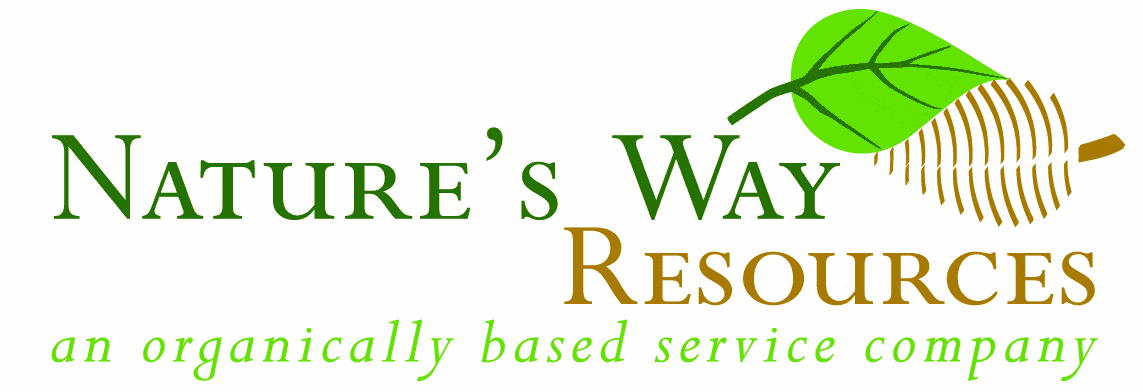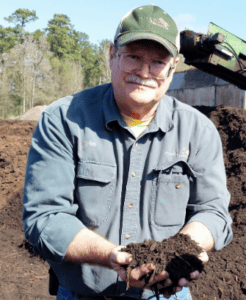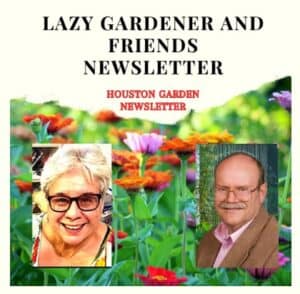 Nature’s Way Resources is proud to produce & email you this free weekly newsletter. We have no ads, but sponsors do graciously help support this project as a public service. Please note their names below & show your gratitude for this free service by patronizing their businesses! To become a sponsor, call (936) 273-1200
Nature’s Way Resources is proud to produce & email you this free weekly newsletter. We have no ads, but sponsors do graciously help support this project as a public service. Please note their names below & show your gratitude for this free service by patronizing their businesses! To become a sponsor, call (936) 273-1200
Nature’s Way Resources owner John Ferguson, “The Lazy Gardener” Brenda Beust Smith and Pablo Hernandez welcome your feedback and are so grateful to the many horticulturists who contribute their expertise
Click here to join our email list
CLICK HERE for PDFs OF PAST LG&F NEWSLETTERS

WHY ISN’T MY FLOWER BLOOMING?
“Flowers are restful to look at.
They have neither emotions nor conflicts.”
— Sigmund Freud (1856-1939)
BRENDA’S NOTE: Not only is it somewhat presumptuous to disagree with Sigmund,I also beg pardon for repeating a column published before. But this same query above repeatedly comes in like clockwork — usually later in summer. But, maybe, seeing these early might help prevent some of those deaths! So . . .
BY BRENDA BEUST SMITH
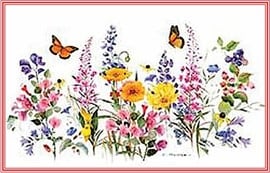 Sorry, Sigmund, but I disagree! I think plants are a LOT like us…
Sorry, Sigmund, but I disagree! I think plants are a LOT like us…
SPOILER
You’re not going to like this …
… but maybe one of these possible causes will help you save plants this year!
Unfortunately, no single pat answer is guaranteed to will tell you the whole story of why your plant isn’t blooming or worse, died. Plants bloom when they’re happy — usually. They pout when not happy — usually. Why might your plant be unhappy? Could it be . . .
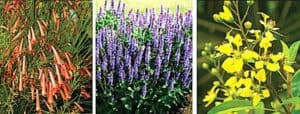 TOO MUCH OR TOO LITTLE WATER? Symptoms are often the same for both sins. Most drought-tolerant plants can’t bloom with too-wet roots, including antique roses, black-eyed Susans, blue daze, bougainvillea, bulbine, cassia, cestrum, coneflowers, Copper Canyon daisy, coreopsis, coral vine, duranta, gaura, hamelia (hummingbird bush), lantana, fernleaf lavender, oleander, pavonia, pride of Barbados (Caesalpinia) and Rangoon creeper. Also, below l to r, russelia, hardy salvia and thyrallis.
TOO MUCH OR TOO LITTLE WATER? Symptoms are often the same for both sins. Most drought-tolerant plants can’t bloom with too-wet roots, including antique roses, black-eyed Susans, blue daze, bougainvillea, bulbine, cassia, cestrum, coneflowers, Copper Canyon daisy, coreopsis, coral vine, duranta, gaura, hamelia (hummingbird bush), lantana, fernleaf lavender, oleander, pavonia, pride of Barbados (Caesalpinia) and Rangoon creeper. Also, below l to r, russelia, hardy salvia and thyrallis.
 TOO LITTLE OR TOO MUCH SUN? Most often too little sun is the culprit. Some plants, including most grafted roses and tomatoes, require morning, noon AND afternoon sun to bloom/bear. Some plants listed for full sun in northern areas may need afternoon shade in our hot climate. On the other hand too much sun may actually inhibit blooming in shade plants such as, l to r below, firespike, barlaria, hostas and ligularia.
TOO LITTLE OR TOO MUCH SUN? Most often too little sun is the culprit. Some plants, including most grafted roses and tomatoes, require morning, noon AND afternoon sun to bloom/bear. Some plants listed for full sun in northern areas may need afternoon shade in our hot climate. On the other hand too much sun may actually inhibit blooming in shade plants such as, l to r below, firespike, barlaria, hostas and ligularia.
- BUD DAMAGE? Buds that won’t open may be infested with thrips, gall midge and other insects. As summer heat kills wildflowers, thrips and other insects search for new food sources. Tear open a few buds. See bugs inside? Kill all bugs and throw away.
- GENETIC PROGRAMMING? Many plants are genetically programmed to produce a certain amount of seed. They track flowers still on stalks. When they’ve reached their quota, they stop flowering. Removing spent blooms tricks these plants into producing more flowers. But newer hybrids are “reblooming” so don’t need “deheading.” How do you tell which you have? Research the specific variety or series name the best you can. Or just try deadheading if blooming slows down.
- IMPROPER PRUNING? Spring-flowering shrubs (azaleas, camellias, bridal wreath, pink magnolias, etc.) bloom on old growth (gone through winter). Pruning in spring before blooming cuts off potential buds. Prune these immediately after blooming. Buds for next year start growing over summer. Summer flowering shrubs bloom on new growth. Prune them in winter. (NOTE! Most of our common garden plants don’t need pruning AT ALL unless they’re growing out-of-bounds. Exception: hybridized roses.)
- INSUFFICIENT NUTRIENTS? We have such a long growing season (sometimes year-round), plants may use up available nutrients. High quality compost will replenish almost all nutrients in a natural manner. A cup of Epsom salts sprinkled around the plant base may help too.
- WRONG FERTILIZER? Simplifying very complex chemical interactions: don’t use a high nitrogen (high first number on bag) lawn food on blooming plants. Nitrogen promotes green growth (not flowers). Don’t put a high phosphorus (high second number) on lawns. Phosphorus triggers blooming (aka weeds that drop seed). Compost is easiest.
- OVERCROWDING? Amaryllis and daylilies are just two of many plants that stop blooming when overcrowded. Lift, separate and replant. Can be done anytime. On the other hand, some plants – bird of paradise, gerbera daisies — flower better when overcrowded.
- IMMATURITY? First come roots, then come flowers . . . in a plant happy world. Young plants don’t want to bloom right away. They want to set good strong roots. Respect that!
- OLD AGE Plants don’t live forever, you know. They can and do die of old age. Since no way of knowing how long a given plant will survive, if it’s a particular favorite, take cuttings or collect seed.
- UNKNOWN PLANT STRESS/DAMAGE? A plant may have been exposed to stressful heat/cold; allowed to completely dry out or treated with stimulants to force blooms that will last on nursery shelves (so you’ll BUY them!). The plant may need to recoup its strength by concentrating on regaining internal health and setting strong roots.
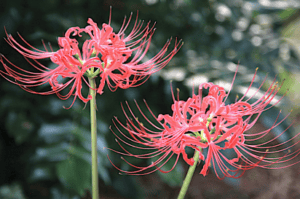 TOO NEW TO GARDEN? Just like us, even healthy plants need to acclimate to a new growing environment, maybe a year or more. Spider lilies, hibiscus, amaryllis, lycoris (right), rainlilies and crinums may be slow to bloom after planting.
TOO NEW TO GARDEN? Just like us, even healthy plants need to acclimate to a new growing environment, maybe a year or more. Spider lilies, hibiscus, amaryllis, lycoris (right), rainlilies and crinums may be slow to bloom after planting.
- WRONG BLOOM TIME? Some plants bloom at different times in different climates. Larkspur, snapdragons, hollyhocks, delphiniums and many daisies bloom later in spring (April, May, June) in colder climates than they do here (Feb., March, April). Use only local bloom advice!
- WRONG PLANTING DEPTH? Everything sinks in our gumbo clay soil with heavy rains, especially bulbs. Too deep roots may stop blooming. Dig up and raise. Azalea and camellia roots want to fan out across upper soil levels. Give them room to spread horizontally. Mulch well but don’t let decaying mulch raise soil levels bury roots too deeply.
- WRONG VARIETY? Some varieties of popular favorites do better here in our subtropical areas than do others. New hybrids that take more or less cold and heat are coming on the market all the time. Your neighborhood independent nurseries will carry varieties that do best for you.
- MAYBE NEEDS A GOOD SPANKING? Ever heard of switching okra? Farmers and fruit tree growers know sometimes sap gets sluggish, triggering a production slow-down. A good switching works on okra. A hardy whacking with a broom may trigger flowers on fruit trees and antique and climbing roses too (personal experience with the efficacy of this one!). One tip: do it at night. Why? So neighbors won’t see you!
- BLAME THE WEATHER? Plants may be a lot smarter than we are. Blooming takes a lot of energy. When they sense intense weather traumas (heat, cold, rainfall, floods, hurricanes) coming, they may stop blooming to conserve energy and concentrate on setting stronger roots.
ON THE OTHER HAND . . . blooms don’t always indicate a happy plant. Spectacular bloom periods often occur after a hurricane, for example, when plants have been hammered by heavy winds. Or after a flood, a severe drought, an unusually cold or a prolonged winter . . . anything that makes them fear for their lives may trigger excessive flowering to produce more seed to ensure continuation of their species.
Sorry if all these possibilities “tighten your jaws” – as an old friend, Mack Cockran, used to say. I know this isn’t the quickie answer folks want. But maybe these options will help you figure it out. Again , , , Sorry, Sigmund!
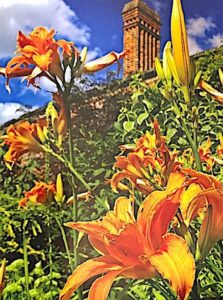 FELDER RUSHING’S #1 WORLD’S FAVORITE PASSALONG PLANT IS . . .
FELDER RUSHING’S #1 WORLD’S FAVORITE PASSALONG PLANT IS . . .
Ta! Da! The common tawny daylily, Hemerocallis fulva. In his worldwide travels (5 continents) he says has seen it in “every kind of garden, from the finest manors and botanical gardens to humble cottage gardens and even in cemeteries. And, he notes, it… “doesn’t set seed, meaning every single one you see is a divided clone of the original plant grown now for over 3000 years.”
Read more, and see this picture enlarged, in Felder’s new book, “Maverick Gardeners.”

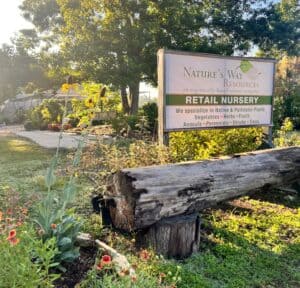 ATTN. GARDEN/PLANT GROUPS — Nature’s Way Resources offers free guided tours of NWR’s extensive nursery/soil/mulch facilities for garden clubs, plant societies and other plant-oriented, organized groups. As usual, NWR’s now-expanded meeting site is free to above groups. Reservations a must for both. Great time to visit!
ATTN. GARDEN/PLANT GROUPS — Nature’s Way Resources offers free guided tours of NWR’s extensive nursery/soil/mulch facilities for garden clubs, plant societies and other plant-oriented, organized groups. As usual, NWR’s now-expanded meeting site is free to above groups. Reservations a must for both. Great time to visit!
- SUBMITTING CALENDAR EVENTS?: These will be in next upcoming newsletter ONLY IF SUBMITTED IN OUR EXACT FORMAT they may be held until can be reformatted. Otherwise, they may be held for reformatting. PS. Apr, 14 National Gardening Day. – You take it from there
John’s Corner
NEWS FROM THE WONDERFUL WORLD
OF SOIL AND PLANTS
Subject: processed foods Brix and Plant health The Jungle Documentary
We frequently talk about the importance of growing our own fruits, vegetables, and herbs. Below is another reason why we need to or at least purchase organic certified foods.
The organization U.S. Right to Know – Pursuing truth and transparency for public health, recently released a report that clearly links many current health problems directly to processed food. It is a well written report that ties Ultra-processed foods directly to cancer, diabetes, dementia, depression, early death, and more.
An issue that all gardeners deal with to some degree is insect and disease problems in our gardens. For years in my garden in Houston before I moved to the country, I rarely had an issue with insects and disease.
Healthy plants have natural defenses against most insects and diseases IF they are grown in soils with the correct nutrition, from trace elements to microbes and enough quality organic matter.
Plant health begins with photosynthesis. When a plant is functioning correctly it produces sugars that provide energy for its immune system and for growth. A gardener can use a refractometer and measure the sugar levels in a plants sap, what is known as a Brix reading. A level 3 or 4 and one will have insect and disease issues, however if one’s soil is healthy and full of nutrients the brix reading can climb to over 15 or more, then disease and insect issues decrease dramatically to almost zero issues.
For this to occur one needs the major elements like nitrogen (N), potassium (K), and phosphorus (P) followed by minor elements like zinc (Zn), copper (Cu), iron (Fe), magnesium (Mg), calcium (Ca), molybdenum (Mo), boron (Bo), etc. When these are present plants can convert nitrogen into complete proteins which help the plant be resistant to insects with simple digestive systems like aphids, and larval insects.
When micronutrients (trace elements are present) plants can produce lipids which they store as a waxy layer on their leaves. This layer serves as armor or a shield that prevents airborne pathogens from entering plant tissue. The micronutrients allow the plants microbiome to be far more effective in protecting a plant.
As the soil gets healthier, organic matter levels rise to 8% or more, the soil is full of microbes (bacteria and fungi) and macrobes (earthworms and arthropods), pest and disease resistance increases again. Plants can now make secondary plant metabolites like flavonoids, terpenoids, and alkaloids. These phytonutrients provide a wide range of protection from chewing insects to viruses.
I remember a lecture I attended many years ago by Jerry Brunetti, a specialist in animal nutrition who stated these secondary plant metabolites were also the anti-cancer compounds when we eat the plants that have them. Unfortunately, most foods today no longer contain them, hence another reason to grow your own food.
The organization FOOD & WATER WATCH is sponsoring a documentary called “The Jungle“ after Upton Sinclair’s 1906 novel. The documentary exposes the current meat packing and how it has changed very little and harms our health and environment.
SPONSORSHIP
If you are interested in becoming a sponsor, please contact us at 936-273-1200 or send an e-mail to: lazygardenerandfriends@gmail.com
ABOUT US
BRENDA BEUST SMITH WE KNOW HER BEST AS THE LAZY GARDENER . . .
but Brenda Beust Smith is also:
- a national award-winning writer & editor
- a nationally-published writer & photographer
- a national horticultural speaker
- a former Houston Chronicle reporter
When the Chronicle discontinued Brenda’s 45-year-old Lazy Gardener” print column — started in the early ’70s as a fun side-project to reporting, it then ranked as the longestrunning, continuously-published local newspaper column in the Greater Houston area. The name, she says, is not just fun, it’s true.
Brenda’s gradual sideways step from reporter into gardening writing led first to an 18-year series of when-to-do-what Lazy Gardener Calendars, then to her Lazy Gardener’s Guide book which morphed into her Lazy Gardener’s Guide on CD, which she now emails free upon request.
Brenda became a Harris County Master Gardener and, over the years, served on theboards of many Greater Houston area horticulture organizations. She hosted local radio and TV shows, most notably a 10+-year Lazy Gardener specialty shows on HoustonPBS (Ch. 8) and her call-in “EcoGardening” show on KPFT-FM.
For over three decades, Brenda served as Assistant Production Manager of the GARDEN CLUB OF AMERICA’S “BULLETIN” magazine. Although still an active broad-based freelance writer, Brenda’s main focus now is THE LAZY GARDENER & FRIENDS HOUSTON GARDEN NEWSLETTER with John Ferguson and Pablo Hernandez of Nature’s Way Resources.
A native of New Orleans and graduate of St. Agnes Academy and the University of Houston, Brenda lives in Humble, TX, and is married to the retired Aldine High School Coach Bill Smith. They have one son, Blake.
Regarding this newsletter, Brenda is the lead writer, originator of it and the daily inspiration for it. We so appreciate the way she has made gardening such a fun way to celebrate life together for such a long time.
About her column, Brenda says: “I don’t consider myself a ‘garden writer.” I started out 50+ years ago as a very lazy “gardening reporter.” I still feel that way today. I hope my columns inspire/help newcomers, but I do not write to them. I write to very experienced gardeners who want to expand their horizons.
JOHN FERGUSON
John is a native Houstonian and has over 35 years of business experience. He owns Nature’s Way Resources, a composting company that specializes in high quality compost, mulch, and soil mixes. He holds a MS degree in Physics and Geology and is a licensed Soil Scientist in Texas.
John has won many awards in horticulture and environmental issues. For years he represented the composting industry on the Houston-Galveston Area Council for solid waste. His personal garden has been featured in several horticultural books and “Better Homes and Gardens” magazine. His business has been recognized in the Wall Street Journal for the quality and value of their products. He is a member of the Physics Honor Society and many other professional societies. John is the co-author of the book Organic Management for the Professional.
For this newsletter, John contributes articles regularly and is responsible for publishing it.
PABLO HERNANDEZ Pablo Hernandez is the special projects coordinator for Nature’s Way Resources. His realm of responsibilities include: serving as a webmaster, IT support, technical problem solving/troubleshooting, metrics management and quality control. Pablo helps this newsletter happen from a technical support standpoint.
Download the Newsletter with Our Events Calendar Below!
